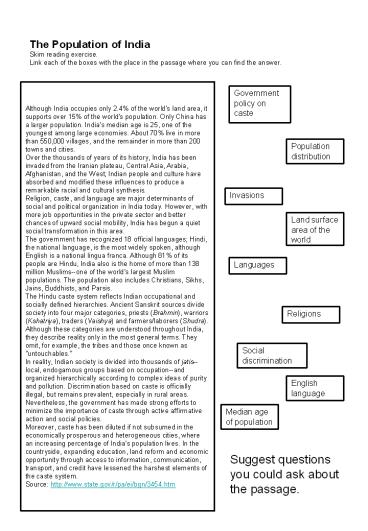The Population of India - PowerPoint PPT Presentation
1 / 1
Title:
The Population of India
Description:
The Population of India Skim reading exercise. Link each of the boxes with the place in the passage where you can find the answer. Although India occupies only 2.4% ... – PowerPoint PPT presentation
Number of Views:58
Avg rating:3.0/5.0
Title: The Population of India
1
The Population of India Skim reading
exercise. Link each of the boxes with the place
in the passage where you can find the answer.
Although India occupies only 2.4 of the world's land area, it supports over 15 of the world's population. Only China has a larger population. India's median age is 25, one of the youngest among large economies. About 70 live in more than 550,000 villages, and the remainder in more than 200 towns and cities. Over the thousands of years of its history, India has been invaded from the Iranian plateau, Central Asia, Arabia, Afghanistan, and the West Indian people and culture have absorbed and modified these influences to produce a remarkable racial and cultural synthesis. Religion, caste, and language are major determinants of social and political organization in India today. However, with more job opportunities in the private sector and better chances of upward social mobility, India has begun a quiet social transformation in this area. The government has recognized 18 official languages Hindi, the national language, is the most widely spoken, although English is a national lingua franca. Although 81 of its people are Hindu, India also is the home of more than 138 million Muslims--one of the world's largest Muslim populations. The population also includes Christians, Sikhs, Jains, Buddhists, and Parsis. The Hindu caste system reflects Indian occupational and socially defined hierarchies. Ancient Sanskrit sources divide society into four major categories, priests (Brahmin), warriors (Kshatriya), traders (Vaishya) and farmers/laborers (Shudra). Although these categories are understood throughout India, they describe reality only in the most general terms. They omit, for example, the tribes and those once known as "untouchables." In reality, Indian society is divided into thousands of jatis--local, endogamous groups based on occupation--and organized hierarchically according to complex ideas of purity and pollution. Discrimination based on caste is officially illegal, but remains prevalent, especially in rural areas. Nevertheless, the government has made strong efforts to minimize the importance of caste through active affirmative action and social policies. Moreover, caste has been diluted if not subsumed in the economically prosperous and heterogeneous cities, where an increasing percentage of India's population lives. In the countryside, expanding education, land reform and economic opportunity through access to information, communication, transport, and credit have lessened the harshest elements of the caste system. Source http//www.state.gov/r/pa/ei/bgn/3454.htm
Government policy on caste
Population distribution
Invasions
Land surface area of the world
Languages
Religions
Social discrimination
English language
Median age of population
Suggest questions you could ask about the passage.

